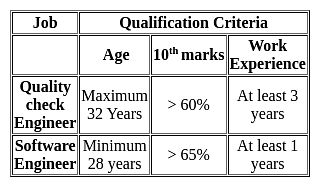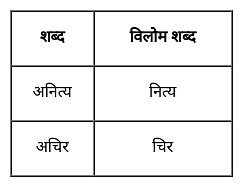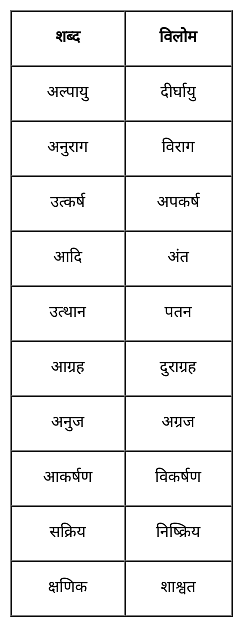NVS PGT Chemistry Mock Test - 1 - NVS TGT/PGT MCQ
30 Questions MCQ Test - NVS PGT Chemistry Mock Test - 1
What will be the color of litmus solution when mixed with sulfuric acid?
| 1 Crore+ students have signed up on EduRev. Have you? Download the App |
A group of friends are sitting in an arrangement with one each at the corner of an octagon. All are facing the centre. Medha is sitting diagonally opposite Radha. Medha is on Seema’s left. Raman is next to Seema and opposite Govind. Govind is on Chandra’s right. Shanti is not on Medha’s right but is opposite to Shashi. Who is opposite Chandra?
Amit is twice as good as Ramit. Working together they can complete the work in 28 days. In how many days can Ramit alone can do the same whole work?
To qualify for a post of Quality check Engineer in an IT company, the maximum age can be of 32 years, 10th marks should be more than 60% and work experience should be at least 3 years. To qualify for Software Engineer, one should have a minimum age of 28 years, 10th marks should be more than 65%, and work experience of at least 1 year. Rajat has 64% marks in 10th an age of 27 years and work experience of 5 years. For which of these jobs does he qualify?
Where ICT can be less useful and has its own drawback when it comes to communication -
One of the main technological edges of ICT involves in enhancing interactive communication among people staying at varied locations through electronic devices. This technology is called as?
What are the objectives of ICT in the education system?
The instructions provided by the teacher must be based on a child's
The basis of selection of a teaching aid is
- age of the learner
- objectives of teaching
- intellectual level of the learner
Choose from the options given below:
Shalini investigates a topic thoroughly and does not need to be over-directed. In which learning phase is she?
What are the characteristics of Continuous and Comprehensive Evaluation (CCE)?
(a) It increases the workload on students by taking multiple tests.
(b) It replaces marks with grades.
(c) It evaluates every aspect of the student.
(d) It helps in reducing examination phobia.
Select the correct answer from the codes given below
Which of the following concentration factor is affected by change in temperature ?
[AIEEE-2002]
Direction (Q. Nos. 1-7) This section contains 7 multiple choice questions. Each question has four choices (a), (b), (c) and (d), out of which ONLY ONE is correct.
Q.
The hybridisation of N in solid state for N2O5 is

The alkene formed as a major product in the above elimination reaction is
[AIEEE 2006]
Due to the presence of electrons in the inner shells, the electron in the outer shell will not experience the full positive charge of the nucleus (Ze). This is known as
The atom which defines the structure of a family of organic compounds and their properties is called ___________
In which of the following solids, ions of opposite charges are held together by strong electrostatic forces of attraction?
Which among the following has square pyramidal geometry?
The term 'Curriculum' in the field of education refers to:
What is scattering of light by mist on head light of vehicles called?
In the following question, an idiomatic expression and its four possible meanings are given. Find out the correct meaning of the idiom.
Q. The project team was working against the clock to get the beta launch done.
In the following question, four words are given out of which one word is incorrectly spelt. Find the incorrectly spelt word.
In the following question, out of the four alternatives, select the alternative which is the best substitute for the phrase.In the following question, out of the four alternatives, select the alternative which is the best substitute for the phrase.
Q. A person who does not believe in the existence of God.
Directions: In the following question, a sentence has been given in Active/Passive voice. Out of four alternatives suggested, select the one which best expresses the same sentence in Passive/Active voice.
Q. Alice posted the letter.




























